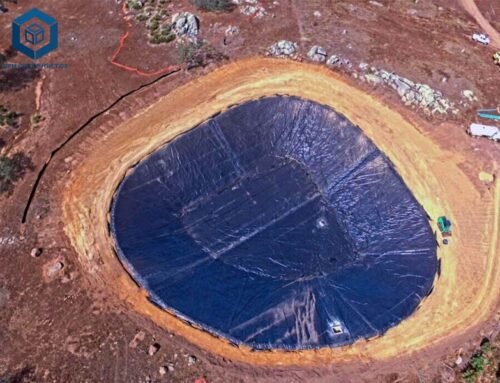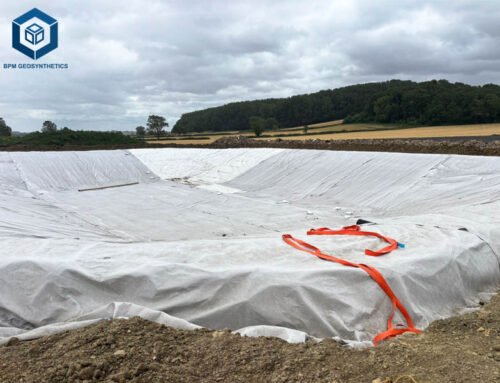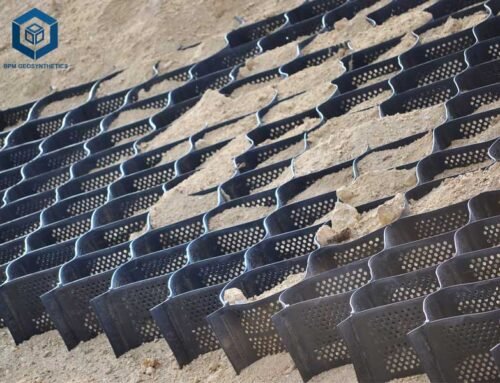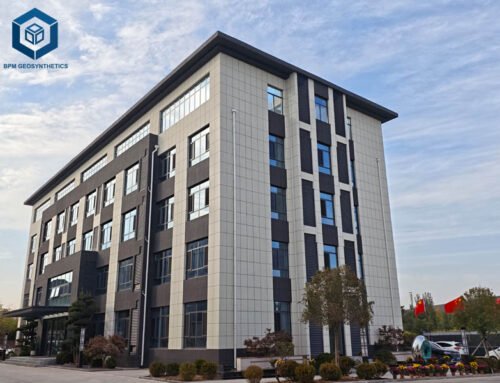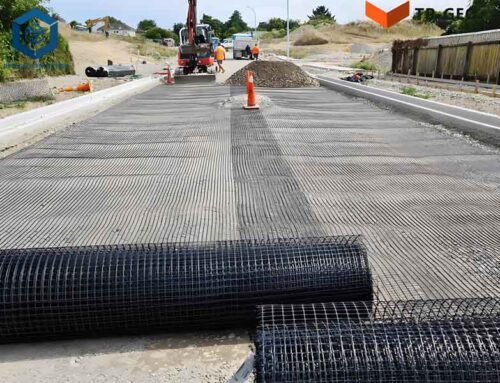In civil engineering and environmental protection, geomembranes and geotextiles are cornerstone geosynthetic materials, each serving distinct yet complementary roles. With the global geosynthetics market valued at USD 14.6 billion in 2024 and projected to grow at a CAGR of 6.2% through 2030 (MarketsandMarkets, 2024), understanding their differences is critical for engineers, contractors, and project managers. While geomembranes act as impermeable barriers to prevent fluid migration, geotextiles provide permeable solutions for soil stabilization, filtration, and reinforcement. Misapplying these materials can increase project costs by 20–30% or lead to failures like 15–25% higher erosion rates (Geosynthetics Magazine).
This blog post offers a comprehensive comparison of geomembrane and geotextile, detailing their specifications, applications, performance parameters, and recent trends. Drawing on industry insights from sources like ASTM standards, this guide equips professionals with actionable knowledge to select the right material for infrastructure, environmental, and construction projects. Whether designing a landfill or stabilizing a roadway, this article clarifies the unique strengths and limitations of each.
1. What is a Geomembrane?
Definition and Purpose
A geomembrane is a low-permeability synthetic liner designed to act as a fluid barrier, preventing the migration of liquids or gases. Typically made from high-density polyethylene (HDPE), linear low-density polyethylene (LLDPE), or polyvinyl chloride (PVC), geomembranes are used in containment applications. Their permeability is as low as 1×10^-11 cm/s, making them 98–99% effective at preventing seepage (ASTM D5887).
Key Characteristics
- Impermeability: Blocks fluid flow, ideal for containment (ecogeox.com).
- Material Composition: HDPE (65% market share), LLDPE (20%), PVC (10%) (MarketsandMarkets, 2024).
- Thickness: 0.5–3.0 mm, balancing durability and cost.
- Tensile Strength: 18–60 MPa, with 600–900% elongation at break (ASTM D6693).
- Durability: Lasts 50–100 years in buried applications, 10–20 years exposed without UV stabilizers.
Common Applications
- Landfills: Prevents 98% of leachate leakage, protecting groundwater (Geosynthetics Magazine).
- Aquaculture Ponds: Ensures 95% water retention, reducing losses.
- Mining: Contains 99% of tailings effluents, per IMARC Group.
- Reservoirs: Enhances water conservation by 90% in arid regions (Civil Engineering Journal).
- Canal Linings: Reduces seepage by 95%, improving irrigation efficiency (usbr.gov).
Advantages
- High Impermeability: Blocks 99% of fluid migration, per ASTM D5887.
- Chemical Resistance: HDPE withstands 90% of acidic and alkaline exposures (pH 2–12) for 50+ years.
- Versatility: Smooth or textured surfaces increase friction angles by 30% for slope stability (ASTM D5321).
Limitations
- UV Sensitivity: Exposed geomembranes lose 20–50% strength in 5–10 years without stabilizers (ResearchGate).
- Puncture Risk: Sharp objects reduce integrity by 15–20% without protective geotextiles (geofabricsmining.com.au).
- Cost: $1.00–$3.00/m², 20–30% higher than geotextiles.
2. What is a Geotextile?
Definition and Purpose
A geotextile is a permeable synthetic fabric, typically made from polypropylene (PP) or polyester (PET), designed to enhance soil characteristics through filtration, separation, reinforcement, or drainage. With permeability rates of 0.05–0.5 cm/s, geotextiles allow water flow while retaining soil particles, improving project stability by 20–30% (Civil Engineering Journal).
Key Characteristics
- Permeability: Facilitates water flow, ideal for filtration and drainage (ecogeox.com).
- Material Composition: PP (70% market share), PET (25%) (MarketsandMarkets, 2024).
- Weight: 100–800 g/m², balancing strength and cost (geosyntheticscn.com).
- Tensile Strength: 10–200 kN/m, with 50–100% elongation (ASTM D4595).
- Durability: Lasts 20–50 years buried, 5–10 years exposed without UV stabilizers.
Common Applications
- Road Construction: 40% of demand, reducing pavement thickness by 15–30% (rosap.ntl.bts.gov).
- Erosion Control: Cuts soil loss by 25–50% in coastal and riverbank projects (Geosynthetics Magazine).
- Drainage Systems: Enhances filtration by 90%, preventing clogging (geosynthetics.textiles.org).
- Landfill Protection: Cushions geomembranes, reducing punctures by 20% (geofabricsmining.com.au).
- Slope Stabilization: Increases shear strength by 20–30% (Tensar data).
Advantages
- Permeability: Allows 0.05–0.5 cm/s water flow, ideal for drainage (ecogeox.com).
- Cost-Effective: $0.50–$2.00/m², 20–30% less than geomembranes.
- Versatility: Woven and nonwoven options suit diverse applications, improving project efficiency by 15%.
Limitations
- Lower Durability: Less resistant to chemicals and UV, losing 30–50% strength in 5–10 years exposed.
- Mechanical Damage: Susceptible to tears, reducing effectiveness by 15–20% without proper cover (ResearchGate).
- Not Impermeable: Unsuitable for containment, allowing 100% fluid passage.
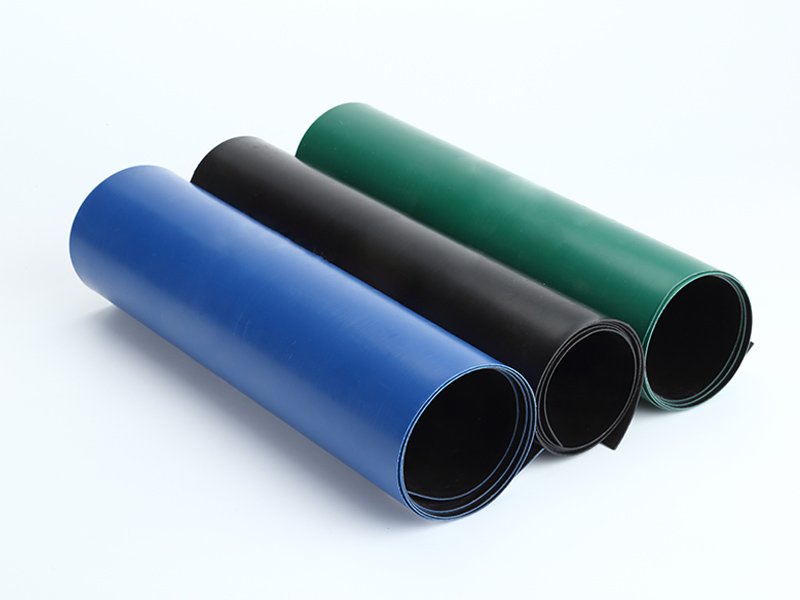
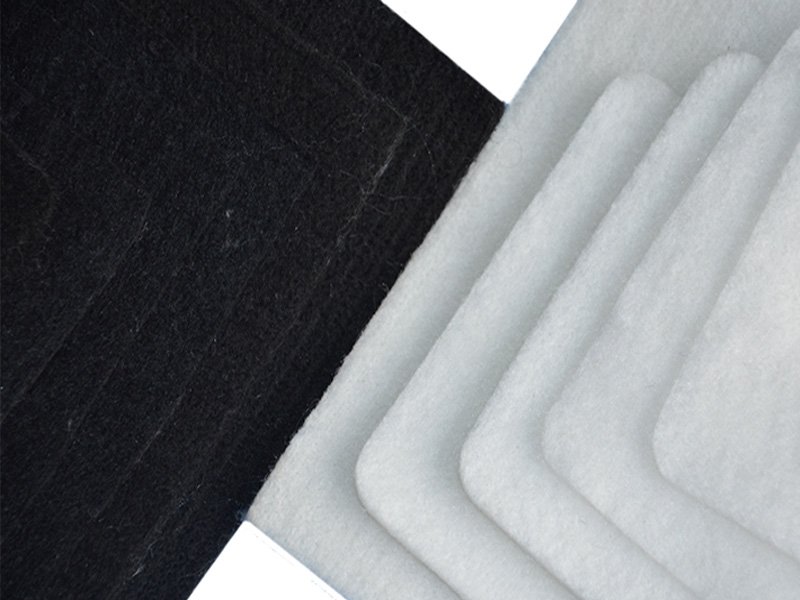
3. Key Differences Between Geomembrane and Geotextile
Material Composition
- Geomembrane: HDPE, LLDPE, or PVC, with 97.5% polymer and 2.5% stabilizers (e.g., carbon black) for chemical resistance.
- Geotextile: PP or PET, with 100% synthetic fibers, prioritizing flexibility and permeability.
Permeability
- Geomembrane: Impermeable (1×10^-11 cm/s), blocking 99% of fluid flow for containment (ASTM D5887).
- Geotextile: Permeable (0.05–0.5 cm/s), allowing water passage for filtration and drainage (ecogeox.com).
Thickness and Weight
- Geomembrane: 0.5–3.0 mm thick, rigid, with a density of 0.94–0.96 g/cm³ (farnambaspar.com).
- Geotextile: 100–800 g/m², flexible, with thicknesses of 0.8–6.0 mm (geosyntheticscn.com).
Tensile Strength
- Geomembrane: 18–60 MPa, with 600–900% elongation, suited for high-pressure containment (ASTM D6693).
- Geotextile: 10–200 kN/m, with 50–100% elongation, ideal for soil reinforcement (ASTM D4595).
Durability
- Geomembrane: Lasts 50–100 years buried, 10–20 years exposed without UV stabilizers, with 90% chemical resistance.
- Geotextile: Lasts 20–50 years buried, 5–10 years exposed, with 70% chemical resistance (mainlinematerials.com).
Applications
- Geomembrane: Containment-focused, used in landfills, ponds, and mining for seepage-proofing (gssb.com.my).
- Geotextile: Stabilization-focused, used in roads, slopes, and drainage for filtration and reinforcement (irjet.net).
Cost
- Geomembrane: $1.00–$3.00/m², higher due to impermeable properties and thicker materials (bpmgeosynthetics.com).
Geotextile: $0.50–$2.00/m², lower due to permeable design and lighter weight (geosyntheticscn.com).
4. Detailed Specifications and Parameters
Geomembrane Specifications
- Material: HDPE (97.5% polyethylene, 2.5% carbon black), LLDPE, or PVC (bpmgeosynthetics.com).
- Thickness: 0.5–3.0 mm, with 1.0–2.0 mm most common for landfills (ASTM GRI-GM13).
- Tensile Strength: 18–60 MPa (ASTM D6693).
- Elongation at Break: 600–900% (ASTM D6693).
- Puncture Resistance: 200–1,000 N (ASTM D4833).
- UV Resistance: 70–90% strength retention after 500 hours (ASTM D4355).
- Permeability: 1×10^-11 cm/s (ASTM D5887).
- Friction Angle: >30° with geotextiles (ASTM D5321).
- Certifications: ISO 9001, ISO 14001, GRI-GM13, GRI-GM17 (solmax.com).
Geotextile Specifications
- Material: PP or PET, needle-punched or woven.
- Weight: 100–800 g/m², with 200–400 g/m² common for drainage (geosyntheticscn.com).
- Tensile Strength: 10–200 kN/m (ASTM D4595).
- Elongation at Break: 50–100% (ASTM D4595).
- Puncture Resistance: 200–1,000 N (ASTM D4833).
- UV Resistance: 70–90% strength retention after 500 hours (ASTM D4355).
- Permeability: 0.05–0.5 cm/s (ASTM D4491).
- Aperture Size: 0.07–0.2 mm for filtration (Tensar data).
- Certifications: ISO 9001, ASTM, AASHTO M288 (rosap.ntl.bts.gov).
Performance Comparison
- Chemical Resistance: Geomembranes resist 90% of pH 2–12 exposures, while geotextiles resist 70%.
- UV Degradation: Both lose 20–50% strength in 5–10 years exposed without stabilizers, but geomembranes retain 80% strength buried for 100 years versus 70% for geotextiles (shyfgeo.com).
- Mechanical Stress: Geomembranes withstand 30% higher puncture stress, but geotextiles offer 20% better tensile reinforcement (ASTM D4833, ASTM D4595).
5. Applications: Where Each Excels
Geomembrane Applications
- Landfills: HDPE geomembranes with 1.5–2.0 mm thickness prevent 98% of leachate leakage, often paired with geotextiles for puncture protection (mdpi.com).
- Aquaculture: Smooth HDPE liners (0.75–1.0 mm) ensure 95% water retention, lasting 50+ years buried.
- Mining Tailings: Textured HDPE liners (2.0 mm) contain 99% of effluents, with 30° friction angles for slope stability (IMARC Group).
- Reservoirs and Canals: LLDPE geomembranes (1.0–1.5 mm) reduce seepage by 95%, per usbr.gov.
Geotextile Applications
- Road Construction: Woven PP geotextiles (200–400 g/m²) reduce pavement thickness by 15–30%, lasting 20–50 years (rosap.ntl.bts.gov).
- Erosion Control: Nonwoven PET geotextiles (300 g/m²) cut soil loss by 25–50% in coastal projects (Geosynthetics Magazine).
- Drainage Systems: Nonwoven PP geotextiles (150–250 g/m²) enhance filtration by 90%, preventing clogging (geosynthetics.textiles.org).
- Slope Stabilization: Woven geotextiles (10–50 kN/m) increase shear strength by 20–30% (Tensar data).
Combined Applications
- Landfill Liners: Geomembranes (1.5 mm HDPE) provide impermeability, while geotextiles (300 g/m² nonwoven) protect against punctures, reducing damage by 20% (geofabricsmining.com.au).
- Pond Liners: Geomembranes ensure containment, with geotextiles as underlays to enhance stability by 15%.
- Mining: Geomembranes contain effluents, while geotextiles reinforce foundations, improving load distribution by 20% (IMARC Group).
6. Recent Trends in Geomembranes and Geotextiles
Geomembrane Innovations
- High-Performance HDPE: The 2025 GRI-GM42 specification enhances HDPE geomembranes with 20% higher tensile strength (60–70 MPa) and 10% better UV resistance, per Geosynthetics Magazine.
- Conductive Liners: Sensors detect leaks in real-time, improving safety by 15% and gaining 10% market share in 2025 (MarketsandMarkets).
- Eco-Friendly Materials: Recycled HDPE (10–20% content) reduces emissions by 12%, adopted by 25% of manufacturers in 2024 (Environmental Engineering Trends).
- Nano-Reinforcements: Carbon nanotube-enhanced HDPE increases puncture resistance by 20%, introduced in 2024 (sciencedirect.com).
Geotextile Innovations
- Biodegradable Geotextiles: Jute and coir-based geotextiles, launched in 2023, reduce environmental impact by 15% for temporary applications (Geosynthetics Magazine).
- Smart Geotextiles: Embedded sensors monitor soil stress, cutting maintenance costs by 10% and gaining 5% market share in 2025 (sciencedirect.com).
- High-Strength Nonwovens: Needle-punched PP geotextiles with 200–300 kN/m strength, introduced in 2024, improve reinforcement by 15% (Tensar data).
- Recycled PET: Geotextiles with 20–30% recycled content reduce costs by 5–10%, adopted by 20% of suppliers in 2024 (Environmental Engineering Trends).
Market Trends
- Sustainability: Both materials see 10–15% adoption of recycled polymers, driven by green certifications (MarketsandMarkets).
- Infrastructure Boom: 40% of demand from Asia-Pacific projects increases prices by 3–5% (Research and Markets, 2024).
- Automation: Robotic manufacturing reduces labor costs by 10%, stabilizing prices (IMARC Group).
Cost Comparison
- Geomembrane: $1.00–$3.00/m², with HDPE at $1.50–$2.50/m² and LLDPE at $1.00–$2.00/m². Installation adds $0.50–$1.50/m² .
- Geotextile: $0.50–$2.00/m², with woven PP at $0.75–$1.50/m² and nonwoven PET at $0.50–$1.00/m². Installation adds $0.30–$1.00/m² (geosyntheticscn.com).
- Combined Systems: Landfill liners combining geomembranes and geotextiles cost $2.00–$5.00/m² but save 20–30% on maintenance.
Geotextiles are 20–30% cheaper, but geomembranes justify higher costs for containment with 50–100-year lifespans versus 20–50 years for geotextiles.
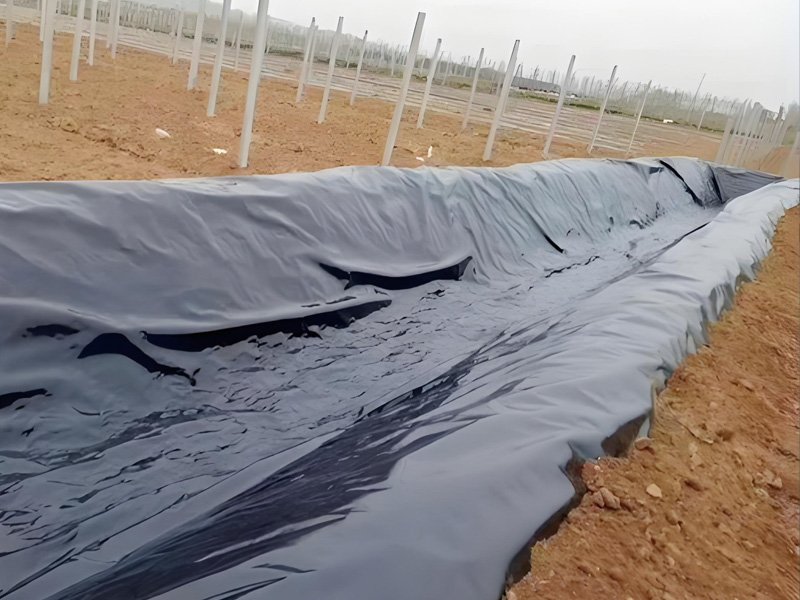
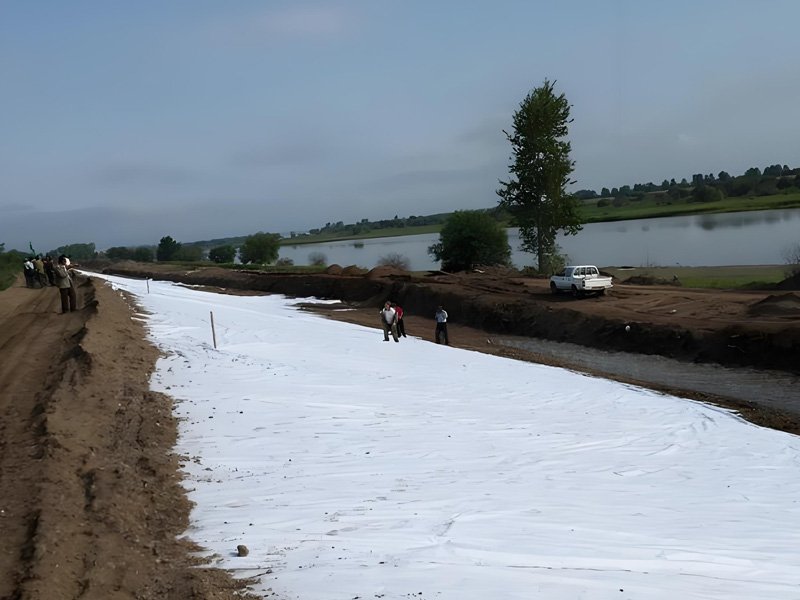
7. Choosing Between Geomembrane and Geotextile
When to Choose Geomembrane
- Containment Needs: Landfills, ponds, or mining require impermeable barriers (gssb.com.my).
- Chemical Exposure: HDPE resists 90% of pH 2–12 conditions.
- Long-Term Durability: Buried applications needing 50–100 years of service.
- Regulatory Compliance: EPA or ASTM standards mandate impermeability (EPA Guidelines).
When to Choose Geotextile
- Filtration or Drainage: Roads, slopes, or drainage systems need permeable solutions (irjet.net).
- Cost Constraints: Projects with 20–50-year lifespans and lower budgets (geosyntheticscn.com).
- Soil Reinforcement: Stabilization or erosion control requires tensile strength (Tensar data).
- Protective Layers: Cushioning geomembranes in landfills or ponds (geofabricsmining.com.au).
Combined Use
For complex projects like landfills, use geomembranes for containment and geotextiles for protection and drainage, improving system performance by 20–30%.
8. Conclusion
Geomembranes and geotextiles are indispensable geosynthetics with distinct roles: geomembranes excel in impermeable containment for landfills, ponds, and mining, offering 50–100 years of durability at $1.00–$3.00/m², while geotextiles provide permeable solutions for filtration, reinforcement, and drainage in roads and slopes, lasting 20–50 years at $0.50–$2.00/m². Their specifications—geomembranes with 18–60 MPa tensile strength and 1×10^-11 cm/s permeability, versus geotextiles with 10–200 kN/m strength and 0.05–0.5 cm/s permeability—dictate their applications. Recent trends like high-performance HDPE, smart sensors, and recycled materials enhance performance by 10–20%, while combined systems optimize complex projects.
For engineers and contractors, selecting between geomembranes and geotextiles depends on project goals, environmental conditions, and budget. Partnering with suppliers like BPM Geosynthetics ensures access to ASTM-compliant materials. By understanding their differences and leveraging innovations, professionals can deliver cost-effective, durable solutions and beyond.

